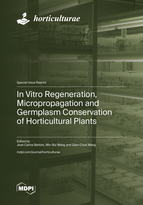In Vitro Regeneration, Micropropagation and Germplasm Conservation of Horticultural Plants
A special issue of Horticulturae (ISSN 2311-7524). This special issue belongs to the section "Propagation and Seeds".
Deadline for manuscript submissions: closed (10 December 2023) | Viewed by 35536
Special Issue Editors
Interests: germplasm conservation; cryopreservation procedures; pathogen eradication; horticultural species; plant tissue culture; micropropagation
Special Issues, Collections and Topics in MDPI journals
Interests: plant tissue culture; cryopreservation; abiotic stress; pathogen eradication
Special Issue Information
Dear Colleagues,
In vitro tissue culture technologies provide novel tools for improving plant production. Organogenesis and somatic embryogenesis are the two pathways for plant regeneration, and have been widely used for in vitro micropropagation and germplasm conservation of horticultural species.
Horticultural plants are usually vegetatively propagated by grafting, rooting of cuttings and layering. The disadvantages of the traditional propagation methods are that they are season-dependent and labor-consuming. Propagated materials are also exposed to attacks of pathogens and pests, and to severe environmental conditions such as drought and extreme temperatures. In vitro micropropagation can avoid these adverse factors and has been widely used for the production of propagating materials of horticultural crops (production of disease-free propagules), particularly perennial woody species and ornamental plants.
The availability of and easy access to genetic resources of diverse plant species is a prerequisite in the breeding of elite cultivars by both classical and novel biotechnological programs. In vitro culture technologies have been widely used to establish medium-term (in vitro conservation) and long-term (cryopreservation) preservation methods for the germplasms of horticultural plants. In vitro conservation and cryopreservation strategies avoid the exposure of stored materials to both adverse abiotic and biotic conditions, and are also cost-effective, which are otherwise involved in field gene collections. Cryopreservation is currently considered an ideal means for long-term storage of plant genetic resources.
This Special Issue publishes research articles and reviews addressing in vitro plant regeneration, micropropagation and germplasm conservation of horticultural plants.
Dr. Jean Carlos Bettoni
Dr. Min-Rui Wang
Prof. Dr. Qiao-Chun Wang
Guest Editors
Manuscript Submission Information
Manuscripts should be submitted online at www.mdpi.com by registering and logging in to this website. Once you are registered, click here to go to the submission form. Manuscripts can be submitted until the deadline. All submissions that pass pre-check are peer-reviewed. Accepted papers will be published continuously in the journal (as soon as accepted) and will be listed together on the special issue website. Research articles, review articles as well as short communications are invited. For planned papers, a title and short abstract (about 100 words) can be sent to the Editorial Office for announcement on this website.
Submitted manuscripts should not have been published previously, nor be under consideration for publication elsewhere (except conference proceedings papers). All manuscripts are thoroughly refereed through a single-blind peer-review process. A guide for authors and other relevant information for submission of manuscripts is available on the Instructions for Authors page. Horticulturae is an international peer-reviewed open access monthly journal published by MDPI.
Please visit the Instructions for Authors page before submitting a manuscript. The Article Processing Charge (APC) for publication in this open access journal is 2200 CHF (Swiss Francs). Submitted papers should be well formatted and use good English. Authors may use MDPI's English editing service prior to publication or during author revisions.
Keywords
- cryopreservation
- in vitro culture
- in vitro conservation
- micropropgation
- plant regeneration








